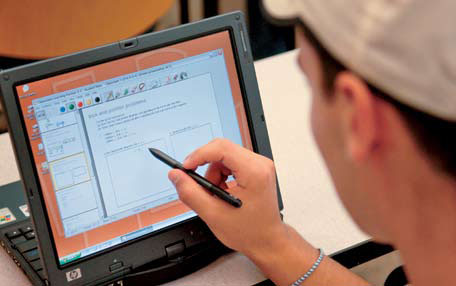
June 2005–December 2006
In large classes, personal interactions between instructor and student can become almost impossible. While transmitters were already being used by students to submit answers via wireless polling, it was limited to posing closedended questions that could only assess recognition rather than true recall.
Using the existing Microsoft Tablet PC–based Classroom Presenter system, the Classroom Learning Partner (CLP) was designed to support exercises in large classrooms, as well as smaller ones. Lecturing with the system, instructors annotate their slides with digital ink displayed simultaneously on-screen and on student Tablet PCs. When slides containing exercises are presented, students work through them and anonymously submit their work wirelessly. The system software then applies artificial intelligence techniques to automatically classify and aggregate the student responses according to patterns specified by the instructor, enabling instructors to see aggregated views of in-class student work in real time, so that they can immediately address common misunderstandings and adapt their presentations.
In addition to developing interpretation and aggregation software, this project completed two studies that evaluated the hypothesis that the use of Tablet PC–based classroom presentation systems such as Classroom Presenter and Classroom Learning Partner increases student learning by (1) increasing student focus and attentiveness in class, (2) providing immediate feedback to both students and instructor about student misunderstandings, (3) enabling the instructor to adjust course material in real time based upon student answers to in-class exercises, and (4) increasing student satisfaction. Results indicate that this hypothesis holds true, and that use of the Classroom Presenter and the Tablet PC may be directly responsible for an increase in performance of students taking MIT introductory computer science. Particularly striking is the increase in performance of those students who might otherwise have done poorly.
The system will be disseminated to the Classroom Presenter community and made available to others via the Web.
Investigators: Dr. Kimberle Koile, Computer Science and Artificial Intelligence Laboratory; Dr. Howard Shrobe, Computer Science and Artificial Intelligence Laboratory; Dr. David Singer, Dept. of Brain and Cognitive Sciences
